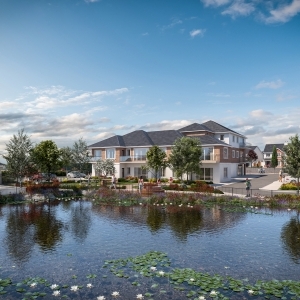How The Structures Should BeDesigned For Minimizing Virus Transmission In The Workplace?
by Josh Maguire Architectural service focused on the design of buiDue to the COVID19 pandemic, businesses have been significantly affected by infectious diseases. Because of the ill-effects of the pandemic, several office buildings have been closed and the workers are confined to lock and key of their home offices. The vaccination development, fortunately, has given some hope to the companies that they will be opened safely. Nevertheless, for ensuring the worker's safety and reducing future operational risks, it is important for the companies to explore the design solutions which will effectively minimize the virus transmission along with other infectious diseases, such as flue as well as the future pandemic-scale infections.

Six Design Features for Minimizing Virus Transmission in the Whole Workplace
With the infectious disease spread, workplaces will be disrupted and it will impact the success of the business, increase the sick days of the employees and lower the net profits. Thus, the companies have to strive to make sure to maintain a safe environment for their employees by consulting the architects and discuss on redoing the architectural design and designing the workplaces which create a healthy indoor environment while minimizing the virus transmissions between the exposed surfaces and individuals.
1. Humidity Management Within the Workspace
The workers are protected in the workspace from viral infections through humidity management, and thereby airborne microbial transmissions decreases. Because of dry hair, mucus membranes and skin are dehydrated due to the skin. The particles penetrate deeper into the respiratory system and leave the workers susceptible to infections. Because of dry air, the particle deposition even reduces, and then ultrafine particles remain in the air for long hours and in the process increase the airborne virus transmission chances. Furthermore, unhealthy mold production takes place due to damp air.
Maintaining 40% to 60% relative humidity in the workspace helps in stopping the harmful impacts from damp and dry air. Through this optimum humidity, viral infectivity even decreases by disruption of the outer membranes of the virus.
2. Increasing Ventilation
By increasing the outdoor air amount coming in indoors, that is ventilation lowers the concentration of airborne virus within a workspace, thereby protecting the workers. There are several ways for improving ventilation, which includes -
- Mechanical features in the form of HVAC systems bringing in outdoor air inside the building
- Increasing natural ventilation through the open doors, windows, kitchen, attic, and bathroom fans.
- The ventilation can be further enhanced through stack ventilation and biopic.
Stack
Ventilation
Often the commercial building allows open windows; nevertheless, they have the capability of achieving natural ventilation through buoyancy and airflow. In simple words, buoyancy favors the entrance of less-dense hot air in rising inside the building, thus creating a vacuum pulling cooler fresh air from below.
Stack ventilation is dependent on ventilators opening and closing whereby air is allowed entry at the bottom of the buildings and exit at the top of the building. Ranging from simple open and close switches, the ventilators integrate energy management systems with temperature, weather sensors, carbon dioxide, and controls for interfacing with the building climate control.
Biophilic
Design
The aim of Biophilic design is maximizing small spaces through the incorporation of large operable windows providing a greater profound sense concerning connection to the outdoors. Biophilic designs seek at connecting interior workspaces to nature and daylight, air quality improvements that result in healthier and more productive employee skills with a lot of robust immune systems.
3. Including More Water Stations
Disease transmission can be significantly mitigated through frequent hand-washing, thereby reducing respiratory illness by 16% to 21%. Thus, designing the workspaces with the much-needed self-contained hand washing stations as well as hand sanitizer dispensers in the high-traffic areas like in the copy rooms, waiting for areas and lobbies, will remarkably reduce virus transmission in the workspaces. Thereby, your employees will be healthy, while their sick days will be reduced.
4. With Touchless Workplace, Surface-to-Person Transmissions will be Significantly Reduced
The high-touch areas of the offices are likely to contain significant viral contamination levels. Now for reducing the surface-to-person disease transmission opportunities, the workspace designers have to limit the shared touchpoints. The features minimizing the touch transmissions like touchless switches opening a door, automatic blind, voice-activated elevators, sensor-flush toilets, and faucets as well as touchless bathroom entry systems must be designed.
5. Select the Quick Decaying Virus Products
Not every building product will be offering virus-free lasting homes. For example, novel coronavirus responsible for COVID19 is likely to survive on stainless steel and plastics for two to three days. So, applying thee anti-viral coatings to the design elements such as door hardware, faucets, and shades even help in preventing the multiplying viruses.
6. Integrated Sensor Technology on the Screen Visitors
For the protection of the people present in the buildings, the workspaces have to be designed with Infrared Fever Screening Systems for screening the visitors to determine their elevated body temperature, before they enter the space.
Therefore, from the discussion, it is clear that a healthy workspace minimizing virus transmission must be created for the benefit of the employee. In healthy environments, employee productivity improves; absenteeism reduces while turnover is marginalized along with workers' compensation as well as medical claims. The employees’ well-being is ultimately protected, while the company profits improve.
Sponsor Ads
Created on Aug 2nd 2021 07:59. Viewed 246 times.



